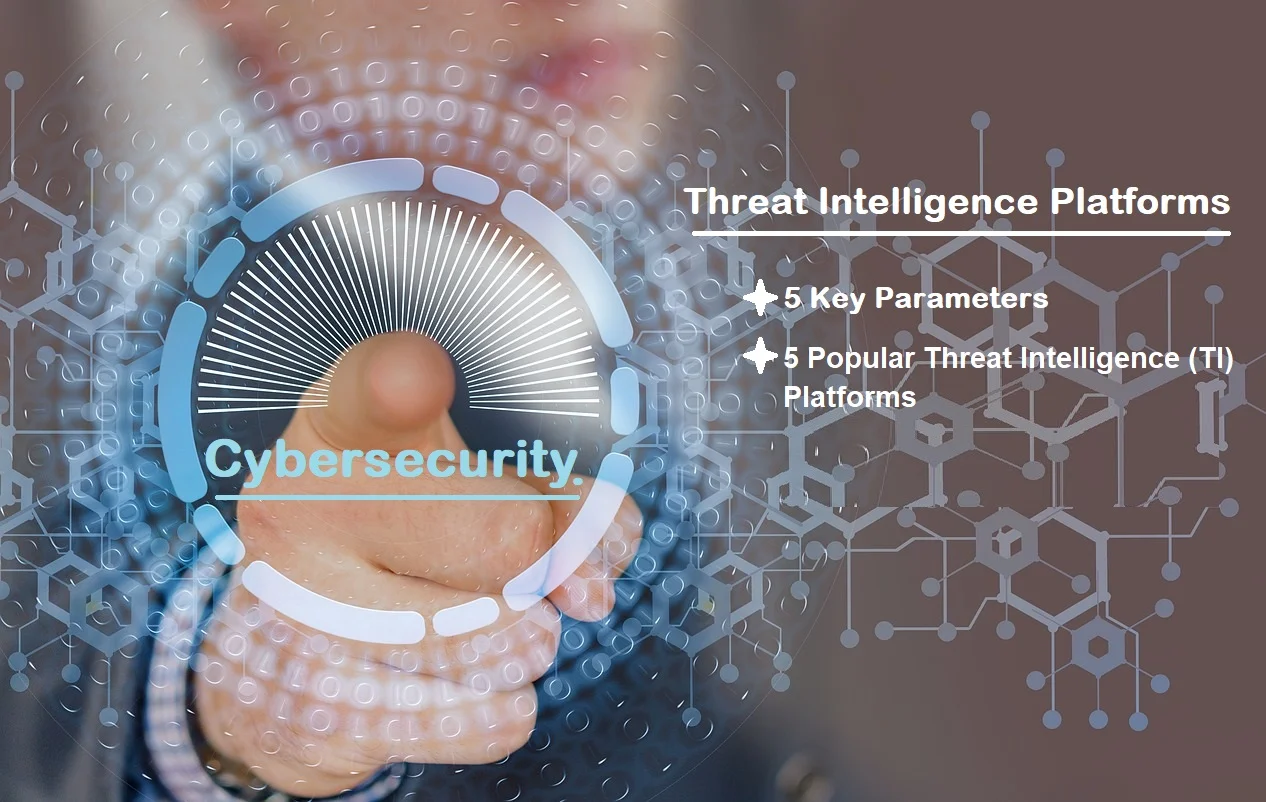Cybersecurity Threat Intelligence Platforms (CTIPs) are becoming increasingly important for organizations looking to enhance their security posture. These platforms enable organizations to collect, analyze, and act upon threat intelligence data from a wide variety of sources, including dark web forums, social media, and other online communities. By using CTIPs, organizations can identify and mitigate cyber threats before they can cause damage to their systems, data, and reputation. In this article, we will explore the key features of CTIPs, their benefits, and the top CTIPs available on the market.
Introduction
Threat Intelligence Platform is software that uses millions of data sources to combine, analyze, collate, and visualize information about cybersecurity threats, attacks, and vulnerabilities so that security professionals are aware of potential risks.
Threat Intelligence Platforms
- Connected to internal systems and external channels to study the environment
- Update data in real-time to show the user the latest global and internal events
- Integrated with incident handling systems
Businesses use cyber intelligence platforms to gather data from a variety of sources and in a variety of formats. Once the threat data is collected and organized, cybersecurity teams can use the TI platforms to obtain information about known threats. With cybercrime levels higher than ever, Threat Intelligence Platforms are quickly gaining popularity in the market.
Cyber intelligence platforms aggregate threat data from different organizations. This enables information security professionals to get the right information about threats and allows them to take proactive actions. Data can be obtained from thousands of different sources, so it is quite difficult to manage it manually. More and more organizations are relying on Threat Intelligence platforms to accurately and timely detect, investigate, and respond to cyberattacks.
With the help of TI platforms, information security specialists will be able to spend more time analyzing data and fixing potential vulnerabilities, rather than investing their resources in collecting and managing the information received. Another benefit of cyber intelligence platforms is their ability to quickly and efficiently share intelligence with other internal and external stakeholders. Threat Intelligence Platforms can be deployed either on-premises or using a Software-as-a-service (SaaS) model.
5 Key Parameters of Threat Intelligence Platforms
Various cyber intelligence platforms are available on the market today, such as stand-alone tools, end-to-end solutions, commercial products, as well as free and open-source solutions. Regardless of the chosen type of instrument, users should evaluate it according to the following five parameters.
1. Dynamic Presentation of Information
The main goal of cyber intelligence is to provide regular and up-to-date information about cyber attacks. This includes both internal and global data. The platform must be linked to endpoints and security systems to monitor the situation for threats. In addition, it must keep up with the constant stream of new and emerging threats around the world. Comprehensive solutions provide customized analysis to reduce internal workload.
2. Workflow Automation
Threat intelligence platforms can deploy automation at multiple levels. They are able to automatically extract and update information feeds without creating special reports. The tools can even integrate with incident management systems to automatically alert and initiate automated troubleshooting. Next-generation Threat Intelligence Platforms use cognitive technologies to filter out the noise and automatically display only high-priority information.
3. Integration with the IT Ecosystem
The chosen TI platform must support integration with the rest of the IT infrastructure. Ideally, this should be a bi-directional integration, which means that IT systems deliver insider threat data to the platform, while the platform feeds the real-time data stream to the security control center. Most platforms include flexible application programming interfaces (APIs) for connecting to almost any software system.
4. Intelligent Data Visualization
Data visualization is at the heart of Threat Intelligence. Data can only be useful to information security professionals if it is presented in a reasonable and easy-to-use form. The platform should include dashboards that support role-based access, data filtering and searching, and layout customization. Threat Intelligence data should be visualized with maps, trend graphs, tables, and charts – as needed – so that security professionals can easily spot correlations and perform deeper analysis.
5. Analysis Tools
A feature that is now becoming more and more popular when choosing cyber intelligence platforms is the built-in analysis tools. Although the platform can be integrated with an external analysis tool using APIs, it is sometimes useful to use built-in threat analysis and investigation tools. For example, built-in search options can help you navigate the vast amount of information contained in your News Feed. Some platforms also support collaborative analysis.
5 Popular Cybersecurity Threat Intelligence (TI) Platforms
According to Mordor Intelligence Research, the market for cyber intelligence platforms is growing: its price has already risen from $5.28 billion and will reach $13.9 billion in the coming years. Let’s take a look at 5 popular TI platforms.
1. Anomaly ThreatStream
Anomali is an American cybersecurity company founded in 2013. It specializes in enterprise-focused Threat Intelligence products.
Special Features:
- Collects data from hundreds of sources and combines them into a single set
- Automatically retrieves and updates data for sharing with stakeholders
- Integrates with existing tools via workbench
- There are interactive panels with tactical, technical, operational, and strategic information about cyber threats
- Includes a visual link analysis tool for matching threat indicators to higher-level threat models
USP:
Anomali ThreatStream is very effective in reducing false positives. The tool can automatically map various Tactics, Techniques, and Procedures (TTPS) using the Visual Explorer tool.
The platform is provided on a paid basis.
Anomali is designed primarily for research. The tool helps collect and correlate global data to investigate the attacker infrastructure but is not always suitable for real-time threat response.
2. Dataminr Pulse
Dataminr is a US company that was founded in 2009. It specializes in threat detection and alerting. The company is known for its patented technology using artificial intelligence.
Special Features:
- Visualization of information in real-time at customizable levels and degrees of specificity; data is collected from over 200,000 publicly available sources
- Automation of data collection and analysis, user alerts
- Datamine Pulse hub provides integrated visibility into the end-to-end IT environment and user landscape
- An AI-powered dashboard that provides information through an intuitive interface and real-time alerts
- Using visualization to help match incidents, this enables information security specialists to jointly analyze and eliminate threats
USP:
Dataminr uses AI-based visualization to provide the visual context needed to address even complex security threats.
The platform is provided on a paid basis.
This platform is suitable for distributed companies due to the close cooperation between information security groups located in different parts of the country or the world; they can jointly conduct asset analysis and threat analysis. It is worth noting that it will take considerable time and effort to set up the platform.
3. IBM X-Force Exchange
IBM is one of the world’s leading software vendors; Founded in 1911. X-Force Exchange is the company’s research initiative for threat intelligence, which is a data exchange platform.
Special Features:
- Dynamically collects data and reports from various public and private sources
- Exchange data feeds are updated automatically, and API-based automation can be configured
- It is possible to integrate X-Force Exchange with firewalls, intrusion prevention systems, and SIEM
- Maps, graphs, reports, and timelines are used to visualize threat data
- You can purchase or subscribe to various analysis tools from the IBM X-Force Exchange App Exchange.
USP:
The platform allows you to familiarize yourself with specific threat types, reports, regions, and activities before investing in protection against them. Companies only need to pay for the information they use.
The platform is provided on a paid basis.
The IBM X-Force Exchange is responsible for public sector research into cyberattacks. Independent threat analysts can benefit from its thriving community. However, the web user interface (UI) is extremely bandwidth hungry and takes a fair amount of time to start up.
4. Mandiant Advantage
Mandiant is a cybersecurity company founded in 2004 and publicly traded on the NASDAQ. The company specializes in Threat Intelligence and security management services.
Special Features:
- Visualizes corporate threats and public safety data in real-time
- Automates incident response using the capabilities of the Mandiant Automated Defense platform
- Integrates with internal cybersecurity controls to perform audits and enforce policies
- Mendiant’s intuitive, role-based dashboards provide all stakeholders with useful information
- It is possible to see the attack surface through the eyes of external malicious objects in order to detect and eliminate all risks.
USP:
The platform is based on the company’s own smart data storage called Mandiant Intel Grid. This provides access to data obtained as a result of more than 900 different activities in the field of information security.
The platform is provided on a paid basis.
Companies with information security monitoring centers (SOCs) can benefit from vendor-independent Mandiant analytics. However, customers note that vulnerability fixes are not always published on time.
5. McAfee Threat Intelligence Exchange
McAfee is an American cybersecurity software company. It is known for its effective offerings for consumers and businesses. The company was founded in 1987 and is listed on the NASDAQ.
Special Features:
- Uses DXL to create data channels from all connected security systems, as well as receive global data
- Automate endpoint protection with custom policies based on risk tolerance
- Can integrate and extract data from various third-party IT systems
- McAfee Threat Intelligence Exchange dashboard displays unknown threat indicators and potentially malicious files
- All information received is analyzed and used to protect against new threats
USP:
McAfee Threat Intelligence Exchange has an adaptive detection feature that speeds up protection against unknown file types.
The platform is provided on a paid basis.
The platform focuses exclusively on endpoint security and related threats. Enterprises with a growing endpoint ecosystem can use this solution in conjunction with other McAfee offerings for complete protection. Companies that require a holistic solution (for example, a solution that spans virtual machines) may need to further invest in other solutions.
Conclusion
Cyber attacks are becoming more complex, so defense mechanisms must evolve at an appropriate pace. Cyber intelligence platforms allow the full range of knowledge of the global cybersecurity community to be used. Data streams are updated in real-time by experts and businesses around the world to stay on top of all possible attack scenarios, even if they have not yet affected the company. When integrated with security tools such as SIEM, TI platforms can help prevent even the most dangerous zero-day attacks. If you find this article helpful you can visit our technology blogs for such type of information.
 SlushWeb Live the Way You Love
SlushWeb Live the Way You Love


